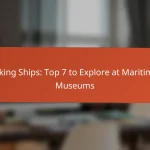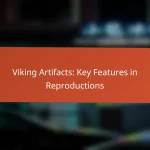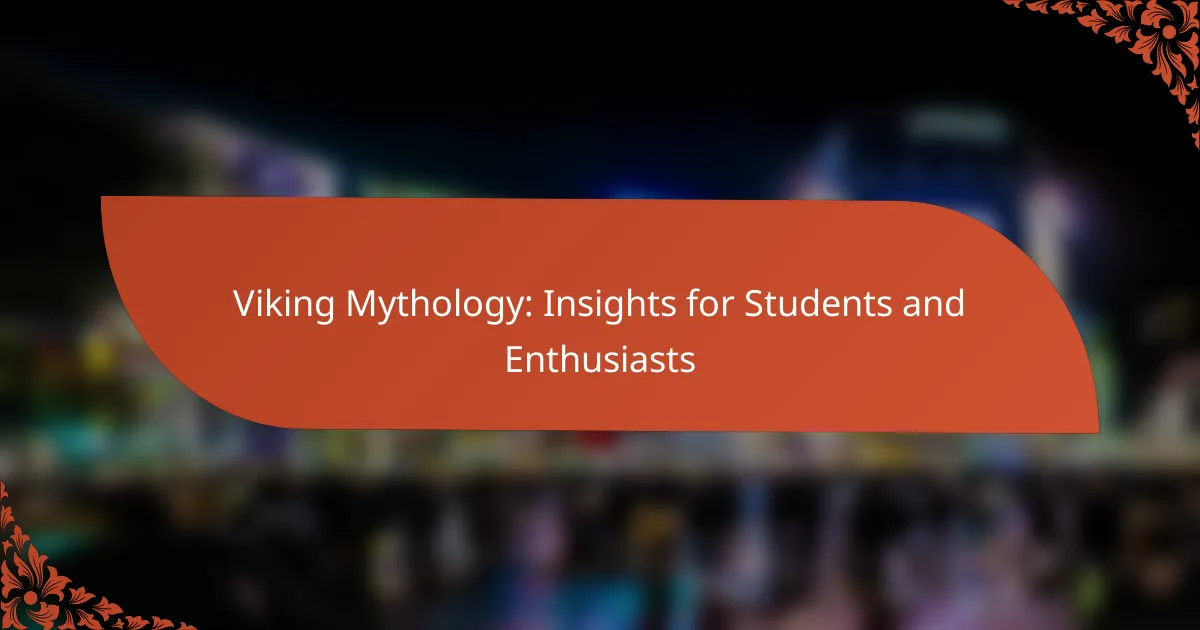Viking mythology offers a rich tapestry of creation myths, a diverse pantheon of gods and goddesses, and intriguing beliefs about the afterlife, reflecting the cultural identity of the Norse people. For students and enthusiasts alike, a variety of resources such as textbooks, online courses, and documentaries can enhance their understanding of these ancient narratives and their significance. Exploring websites, podcasts, and local museums further enriches the journey into this captivating subject.

What are the key themes in Viking mythology?
Key themes in Viking mythology include creation myths, the pantheon of gods and goddesses, mythical creatures, and beliefs about the afterlife. These elements reflect the values, fears, and cultural identity of the Norse people.
Creation myths
Creation myths in Viking mythology explain how the world and its inhabitants came to be. One prominent story describes the formation of the earth from the body of the giant Ymir, whose flesh became land, blood turned into seas, and bones transformed into mountains.
These myths often emphasize the chaotic nature of the universe and the struggle between order and disorder. They serve as a foundation for understanding the Norse cosmos, which is divided into nine realms interconnected by the world tree, Yggdrasil.
Gods and goddesses
The pantheon of Viking gods and goddesses includes well-known figures such as Odin, Thor, and Freyja. Each deity embodies specific aspects of life, such as war, fertility, and wisdom, influencing various aspects of Viking society.
Worship practices often involved rituals and sacrifices to gain favor from these gods. Temples and sacred sites were established, where followers sought guidance and blessings for matters like agriculture and warfare.
Mythical creatures
Viking mythology is rich with mythical creatures, including giants (Jotunn), elves, and dragons. These beings often represent natural forces or human traits, serving as both adversaries and allies to the gods.
For instance, the dragon Fafnir symbolizes greed and destruction, while the wise elves are associated with fertility and prosperity. Understanding these creatures helps to grasp the moral lessons embedded in the myths.
Afterlife beliefs
Afterlife beliefs in Viking mythology revolve around concepts such as Valhalla and Hel. Valhalla, ruled by Odin, is a glorious hall where warriors who died in battle are welcomed, while Hel is a realm for those who died of illness or old age.
These beliefs underscore the importance of honor and bravery in life, as the manner of one’s death determined their fate in the afterlife. Rituals, including burial practices and grave goods, were significant in ensuring a favorable journey after death.
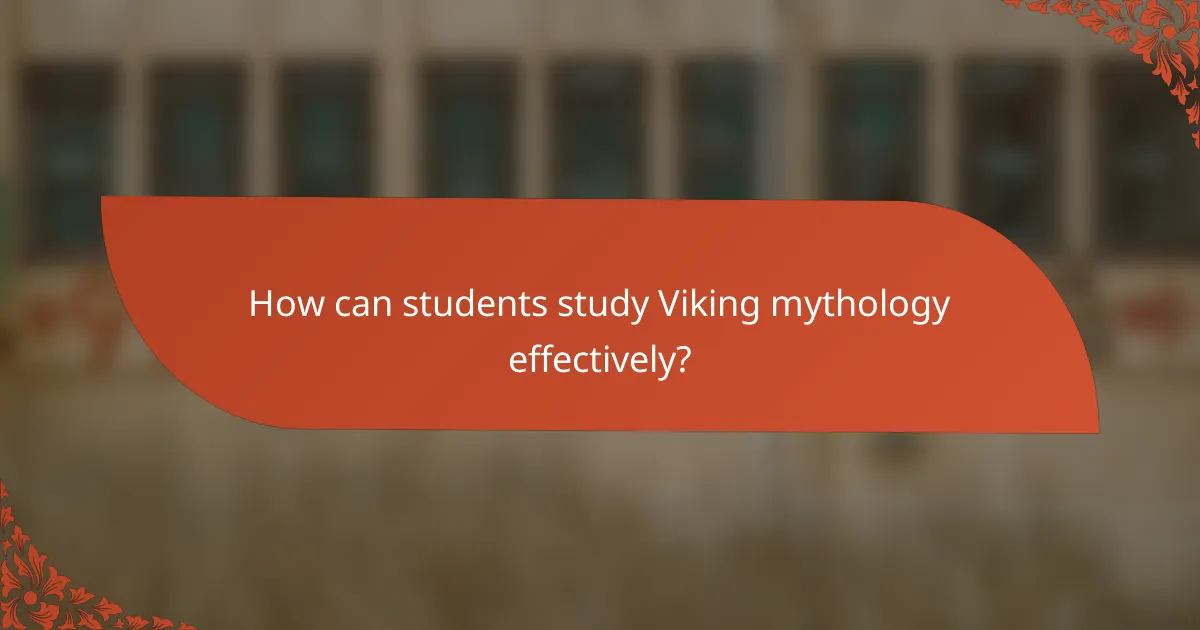
How can students study Viking mythology effectively?
Students can study Viking mythology effectively by utilizing a combination of textbooks, online courses, and documentary films. These resources provide a comprehensive understanding of the myths, gods, and cultural context of the Viking Age.
Recommended textbooks
Textbooks are foundational for studying Viking mythology, offering structured information and scholarly insights. Some notable titles include “Norse Mythology” by Neil Gaiman, which retells classic tales, and “The Prose Edda” by Snorri Sturluson, a primary source for understanding Norse myths.
When selecting textbooks, consider those that include critical analysis and historical context. Look for editions with annotations or commentaries that can enhance understanding.
Online courses
Online courses provide flexible learning options for students interested in Viking mythology. Platforms like Coursera and edX offer courses that cover various aspects of Norse culture and mythology, often taught by university professors.
When choosing a course, check for reviews and the curriculum to ensure it aligns with your interests. Some courses may also offer certificates, which can be beneficial for academic or professional credentials.
Documentary films
Documentary films are an engaging way to visualize and understand Viking mythology. Films such as “The Vikings: Journey to New Worlds” and “Norse Mythology: The Truth Behind the Myths” provide captivating narratives and expert interviews that bring the myths to life.
Look for documentaries that are well-researched and produced by reputable filmmakers. These films can serve as excellent supplementary materials to textbooks and courses, enhancing your overall comprehension of Viking mythology.
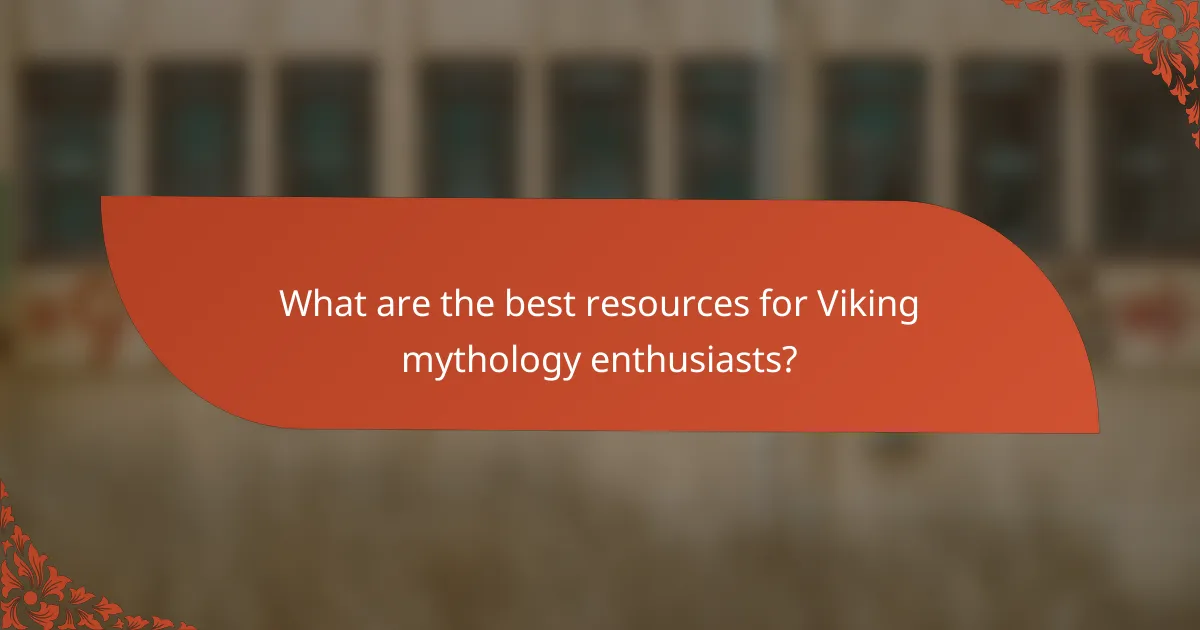
What are the best resources for Viking mythology enthusiasts?
Viking mythology enthusiasts can explore a variety of resources, including websites, podcasts, and local museums, to deepen their understanding of this fascinating subject. These platforms offer insights into Norse gods, sagas, and cultural practices, making them valuable for both students and casual fans.
Websites and blogs
Numerous websites and blogs provide extensive information on Viking mythology. Notable sites include Norse Mythology for Troubled Times and Norse Mythology, which feature articles, analyses, and resources that cater to various levels of interest.
When exploring these sites, look for sections dedicated to specific myths, character analyses, and cultural context. Blogs often provide personal interpretations and discussions, which can enhance your understanding of the material.
Podcasts
Podcasts are an engaging way to learn about Viking mythology while on the go. Shows like The History of Vikings and Norse Mythology delve into tales of gods and heroes, offering expert insights and storytelling that bring the myths to life.
Consider subscribing to multiple podcasts to get a range of perspectives. Many episodes feature interviews with scholars, which can provide deeper context and contemporary relevance to ancient stories.
Local museums
Visiting local museums can provide tangible connections to Viking mythology through artifacts and exhibits. Museums such as the Viking Ship Museum in Oslo and the National Museum of Denmark in Copenhagen showcase Viking ships, tools, and art, giving visitors a glimpse into their world.
Check for special exhibitions or events focused on Viking culture, as these can enhance your experience. Many museums also offer educational programs or guided tours that can deepen your understanding of the artifacts on display.

What are the cultural impacts of Viking mythology in modern society?
Viking mythology significantly influences modern culture, shaping literature, film, and festivals. Its themes of heroism, fate, and the supernatural resonate widely, inspiring various forms of artistic expression and community celebrations.
Influence on literature
Viking mythology has left a profound mark on contemporary literature, inspiring authors across genres. Works ranging from fantasy epics to historical fiction often draw upon Norse gods, legends, and motifs, enriching narratives with rich cultural heritage.
Notable examples include Neil Gaiman’s “Norse Mythology,” which retells classic tales, and J.R.R. Tolkien’s “The Lord of the Rings,” which incorporates elements reminiscent of Norse sagas. This intertextuality enhances readers’ understanding of mythological themes and archetypes.
Representation in films
Films frequently depict Viking mythology, showcasing its dramatic narratives and larger-than-life characters. Popular movies like “Thor” and series such as “Vikings” have brought these ancient stories to mainstream audiences, blending action with mythological elements.
These adaptations often emphasize the heroic journeys and moral dilemmas faced by characters, making the mythology accessible and engaging. However, they may also take creative liberties, so viewers should consider the distinction between myth and cinematic interpretation.
Viking festivals
Viking festivals celebrate Norse culture and mythology, drawing enthusiasts and tourists alike. Events like the Jorvik Viking Festival in the UK and the Viking Festival in Lofoten, Norway, feature reenactments, crafts, and storytelling, allowing participants to immerse themselves in the Viking experience.
These festivals not only promote cultural heritage but also foster community engagement and education about Viking history and mythology. Attendees can enjoy traditional foods, music, and workshops, making these events both entertaining and informative.
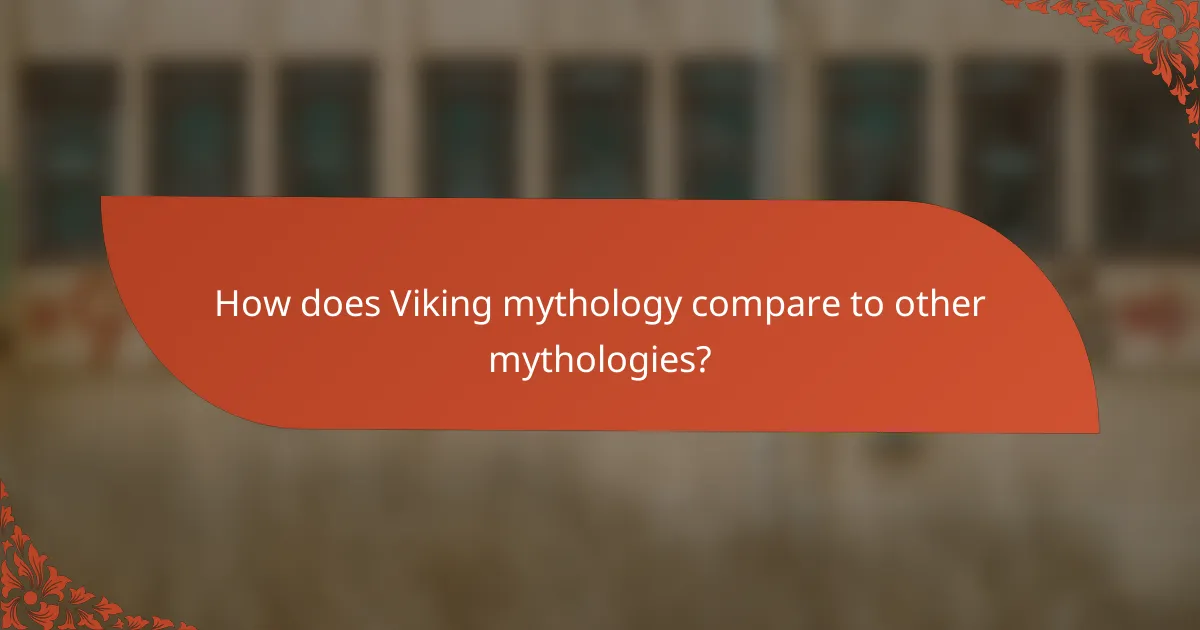
How does Viking mythology compare to other mythologies?
Viking mythology shares both similarities and differences with other mythologies, particularly Norse and Greek traditions. Understanding these aspects can enhance appreciation for its unique narratives and cultural significance.
Similarities with Norse mythology
Viking mythology is essentially a subset of Norse mythology, as it originates from the same cultural and historical context of the Scandinavian people. Both mythologies feature a pantheon of gods, such as Odin and Thor, and emphasize themes of fate, honor, and the afterlife.
Additionally, both traditions include a rich tapestry of myths that explain natural phenomena, human behavior, and the cosmos. For example, the creation myth involving Ymir, the primordial giant, is a central story in both Viking and broader Norse mythology.
Differences from Greek mythology
While Viking mythology and Greek mythology both contain gods and heroes, they differ significantly in themes and character portrayals. Viking myths often focus on the harsh realities of life, emphasizing bravery in the face of inevitable death, whereas Greek mythology frequently explores themes of beauty, love, and human flaw.
Moreover, the gods in Viking mythology are depicted as more fallible and human-like, often engaging in battles and facing their own destinies, unlike the more idealized and often omnipotent gods of Greek mythology. This contrast highlights the Viking worldview, which is steeped in realism and the acceptance of fate.
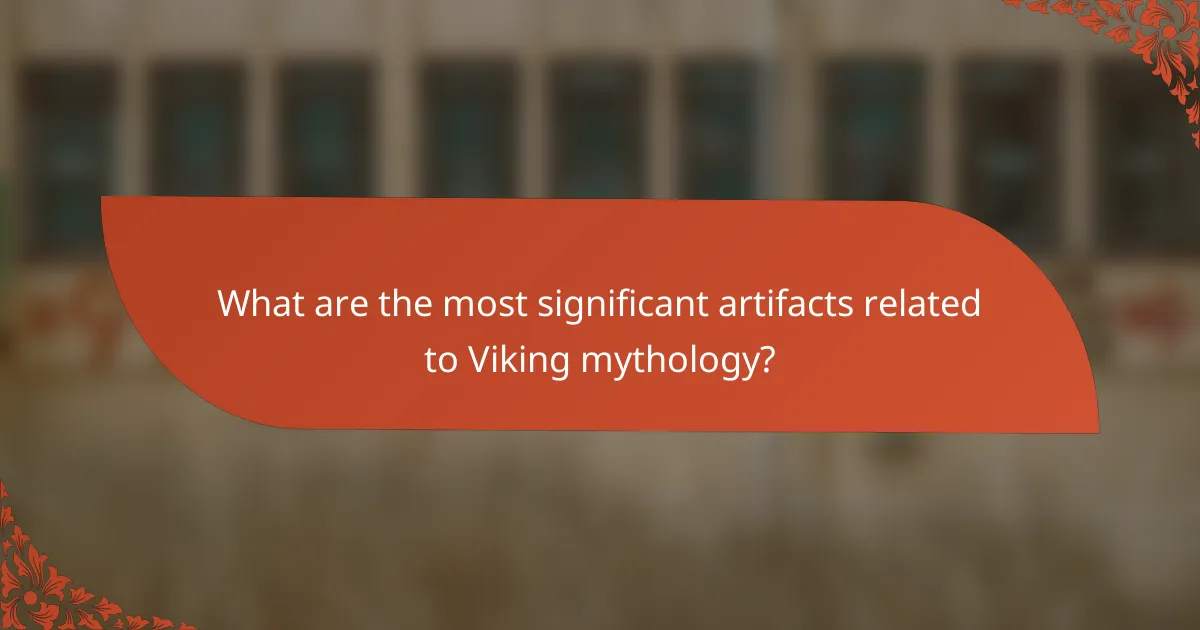
What are the most significant artifacts related to Viking mythology?
The most significant artifacts related to Viking mythology include runestones and items found in burial sites. These artifacts provide valuable insights into the beliefs, practices, and cultural heritage of the Viking Age.
Runestones
Runestones are large stones inscribed with runes, which are characters from the ancient Norse alphabet. These stones often commemorate individuals, events, or deities, serving as historical markers that reflect Viking beliefs and societal values.
Many runestones are found in Scandinavia, particularly in Sweden and Denmark. They typically date back to the 9th to 12th centuries and can vary in size and complexity. Some notable examples include the Jelling stones, which are considered national monuments of Denmark.
Artifacts from burial sites
Artifacts from burial sites, such as weapons, jewelry, and everyday items, offer a glimpse into the lives and beliefs of the Vikings. These items were often placed in graves to accompany the deceased into the afterlife, reflecting their importance in Viking culture.
Common artifacts include swords, shields, and ornate brooches, which signify status and craftsmanship. Notable burial sites, like those found in Oseberg and Gokstad in Norway, have yielded well-preserved ships and a wealth of grave goods, showcasing the richness of Viking mythology and their funerary practices.
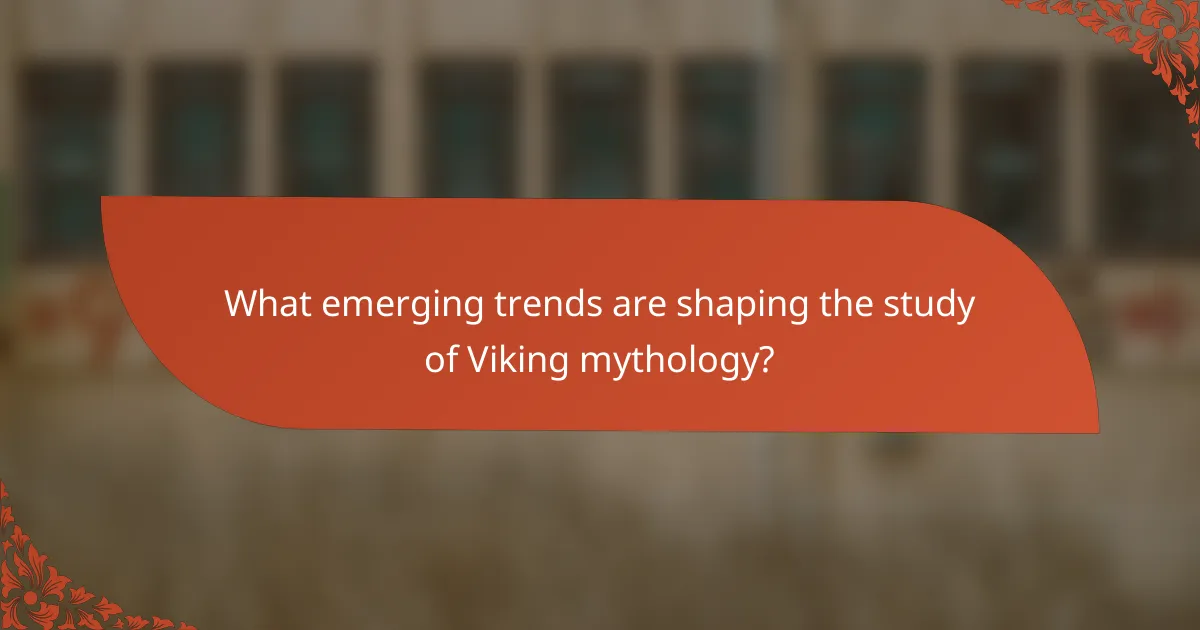
What emerging trends are shaping the study of Viking mythology?
Emerging trends in the study of Viking mythology include interdisciplinary approaches, increased digital resources, and a focus on cultural context. Scholars are now integrating fields like archaeology, linguistics, and anthropology to gain deeper insights into Norse beliefs and practices.
Interdisciplinary approaches
Interdisciplinary approaches combine various fields to enrich the understanding of Viking mythology. For instance, archaeology provides tangible evidence of rituals and artifacts, while linguistics helps decode ancient texts. This collaboration allows for a more holistic view of how mythology influenced Viking society.
Students and enthusiasts can benefit from exploring these intersections. Engaging with multiple disciplines can lead to a more nuanced appreciation of the myths and their significance in historical contexts.
Increased digital resources
The rise of digital resources has transformed the study of Viking mythology, making a wealth of information accessible. Online databases, virtual museums, and digital archives allow researchers and enthusiasts to explore texts and artifacts from anywhere in the world. This accessibility fosters a broader interest and engagement with Norse mythology.
Utilizing these digital tools can enhance research efforts. For example, platforms like Google Arts & Culture provide virtual tours of museums that house Viking artifacts, enriching the learning experience without geographical constraints.
Focus on cultural context
There is a growing emphasis on understanding Viking mythology within its cultural context. This trend highlights how mythology was not just a collection of stories but a reflection of societal values, norms, and historical events. By examining the cultural backdrop, scholars can better interpret the significance of various myths.
For students, considering the cultural context can deepen analysis. Exploring how myths relate to Viking daily life, social structures, and interactions with other cultures can reveal the complexities of Norse beliefs and their lasting impact on modern society.



